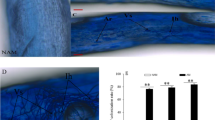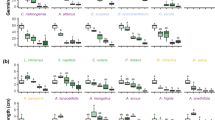Abstract
We tested the hypothesis that fertilized containerized Pinus canariensis seedlings increases survival when planted in semiarid sites through the improvement of their physiological status during the establishment phase by an increment in root growth. Seedlings were cultured under two different regimes: traditional (in non-fertilized natural soil) and alternative (in fertilized peat). Morphological attributes and nitrogen content were measured before planting. Measurements of survival and growth in the plantation were made periodically for 2 years and physiological plant responses (leaf water potential, gas exchange and chlorophyll fluorescence) during the third summer after planting were tested and finally a set of plants were excavated to measure the same parameters as before planting. Seedlings cultivated using fertilized peat achieved the highest values for all of evaluated parameters. During the third dry season, big seedlings exhibited better physiological status. Therefore, enhanced root growth can result in better water uptake during the dry period thereby increasing survival and growth in the next few years after planting. A feed-back physiological model is proposed to explain P. canariensis establishment in a semiarid environment.







Similar content being viewed by others
References
Bernier PY, Lamhamedi MS, Simpson DG (1995) Shoot:root ratio is of limited use in evaluating the quality of container conifer stock. Tree Planters Notes 46:102–106
Boivin JR, Miller BD, Timmer VR (2002) Late-season fertilization of Picea mariana seedlings under greenhouse culture: biomass and nutrient dynamics. Ann For Sci 59:255–264. doi:10.1051/forest:2002021
Boucher JF, Munson AD, Bernier PD (1995) Foliar absorption of dew influences shoot water potential and root growth in Pinus strobus seedlings. Tree Physiol 15:819–823
Burdett AN (1990) Physiological processes in plantation establishment and development of specifications for forest planting stock. Can J For Res 20:415–427
Chaves MM, Oliveira MM (2004) Mechanisms underlying plant resilience to water deficits: prospects for water-saving agriculture. J Exp Bot 55:2365–2384. doi:10.1093/jxb/erh269
Chaves MM, Pereira JS, Maroco JP, Rodriguez ML, Ricardo CPP, Osorio ML, Carvalho I, Faria T, Pinheiro C (2002) How plants cope with water stress in the field: photosynthesis and growth. Ann Bot Lond 89:907–916. doi:10.1093/aob/mcf105
Chaves MM, Maroco JP, Pereira JS (2003) Understanding plant response to drought: from genes to the whole plant. Funct Plant Biol 30:239–264. doi:10.1071/FP02076
Climent J, Alonso J, Gil L (2008) Root restriction hindered early allometric differentiation between seedlings of two provenances of canary Island pine. Silvae Genet (in press)
Cortina J, Valdecantos A, Seva JP, Vilagrosa A, Bello J, Vallejo VR (1997) Relación tamaño-supervivencia en plantones de especies arbustivas mediterráneas producidos en vivero. Actas del II Congreso Forestal Español Mesa 3:159–164
Fernández-Palacios JM, de-Nicolás JP (1995) Altitudinal pattern of vegetation variation on Tenerife. J Veg Sci 6:183–190. doi:10.2307/3236213
Flexas J, Medrano H (2002) Drought-inhibition of photosynthesis in C3 plants: stomatal and non-stomatal limitation revisited. Ann Bot Lond 89:183–189. doi:10.1093/aob/mcf027
Flexas J, Bota J, Escalona JM, Sampol B, Medrano H (2002a) Effects of drought in grapevines under field conditions: an evaluation of stomatal and mesophyll limitations. Funct Plant Biol 29:461–471. doi:10.1071/PP01119
Flexas J, Escalona JM, Evain S, Gulías J, Moya I, Osmond CB, Medrano H (2002b) Steady-state chlorophyll fluorescence (Fs) measurements as a tool to follow variations of net CO2 assimilation and stomatal conductance during water-stress in C3 plants. Physiol Plant 114:231–240. doi:10.1034/j.1399-3054.2002.1140209.x
Flexas J, Bota J, Cifre J, Escalona JM, Galmes J, Gulías J, Lefi EK, Martínez-Cañellas SF, Moreno MT, Ribas-Carbó M, Riera D, Sampol B, Medrano H (2004) Understanding down-regulation of photosynthesis under water stress: future prospects and searching for physiological tools for irrigation management. Ann Appl Bot 144:273–283. doi:10.1111/j.1744-7348.2004.tb00343.x
Fraysse JY, Crémière L (1998) Nursery factors influencing containerized Pinus pinaster seedlings’ initial growth. Silva Fenn 32:261–270
Genty B, Briantais JM, Baker NR (1989) The relationships between the quantum yield of photosynthetic electron transport and quenching of chlorophyll fluorescence. Biochim Biophys Acta 990:87–92
Gough CM, Seiler JR (2004) The influence of environmental, soil carbon, root, and stand characteristics on soil CO2 efflux in loblolly pine (Pinus taeda L.) plantations located on the South Carolina Coastal Plain. For Ecol Manage 191:353–363. doi:10.1016/j.foreco.2004.01.011
Green TH, Mitchell RJ (1992) Effects of nitrogen on the response of loblolly pine to water stress. I. Photosynthesis and stomatal conductance. New Phytol 122:627–633
Grossnickle SC (2000) Ecophysiology of Northern Spruce Species: the performance of planted seedlings. NCR Research Press, Ottawa, p 409
Grossnickle SC (2005) Importance of root growth in overcoming planting stress. New For 30:273–294. doi:10.1007/s11056-004-8303-2
Haase DL, Rose RW (1993) Soil moisture stress induces transplant shock in stored and unstored 2 + 0 Douglas-fir seedlings of varying root volumes. For Sci 39:275–294
Harley PC, Tenhunen JD, Lange OL, Beyschlag W (1987) Seasonal and diurnal patterns in leaf gas exchange of Phillyrea angustifolia growing in Portugal. In: Tenhunen JD, Catarino FM, Lange OL, Oechel WC (eds) Plant response to stress: functional analysis in Mediterranean ecosystems, NATO ASI series, vol l, G15. Springer-Verlag, Berlin, pp 329–337
Jose S, Merritt S, Ramsey CL (2003) Growth, nutrition, photosynthesis and transpiration responses of longleaf pine seedlings to light, water and nitrogen. For Ecol Manage 180:335–344. doi:10.1016/S0378-1127(02)00583-2
Lamhamedi MS, Bernier PY, Hébert C (1997) Effect of shoot size on the gas exchange and growth of containerized Picea mariana seedlings under different watering regimes. New For 13:209–223. doi:10.1023/A:1006586325524
Loreto F, Tricoli D, Di Marco G (1995) On the relationship between electron transport rate and photosynthesis in leaves of C4 plant Sorghum bicolor exposed to water stress, temperature changes and carbon metabolism inhibition. Aust J Plant Physiol 22:885–892
Luis VC (2006) Calidad de planta de pino canario para reforestación. Métodos de cultivo y respuestas fisiológicas a factores de estrés. Doctoral thesis. La Laguna University, Spain. 186 pp
Luis VC, Peters J, González-Rodríguez AM, Jiménez MS, Morales D (2004) Testing nursery plant quality of Canary Island pine seedlings grown under different cultivation methods. Phyton 44:231–244
McKay HM (1997) A review of the effect of stresses between lifting and planting on nursery stock quality and performance. New For 13:363–393
Medrano H, Escalona JM, Bota J, Gulías J, Flexas J (2002) Regulation of photosynthesis in C3 plants in response to progressive drought: the interest of stomatal conductance as a reference parameter. Ann Bot Lond 89:895–905. doi:10.1093/aob/mcf079
Mexal JG, Landis TD (1990) Target seedlings concepts: height and diameter. In: Rose R et al (eds) Target seedling symposium. In: Proceedings, combined meeting of the western nursery associations. Roseburg, OR. GTR: RM 200. USDA Forest Service, pp 17–34
MMA (2008) Ministerio de Medio Ambiente. Los incendios forestales en España. Año 2007. IV International conference of forest fires, pp 34
Morales D, Peters J, Jiménes MS, Tausz M, Wonish A, Grill D (1999) Gas exchange of irrigated and non-irrigated Pinus canriensis seedlings growing outdoors in La Laguna, Canary Islands. Spain Z Naturforsch 54c:693–697
Munné-Bosch S, Alegre L (2000) Changes in carotenoids tocopherols and diterpenes during drought and recovery, and the biological significance of chlorophyll loss in Rosmarinus officinallis plants. Planta 210:925–931. doi:10.1007/s004250050699
Munné-Bosch S, Nogués S, Alegre L (1999) Diurnal variations of photosynthesis and dew absorption by leaves in two evergreen shrubs growing in Mediterranean field conditions. New Phytol 144:109–119. doi:10.1046/j.1469-8137.1999.00490.x
Nogués S, Alegre L (2002) An increase in water deficits has no impact on the photosynthetic capacity of field-grown Mediterranean plants. Funct Plant Biol 29:621–630. doi:10.1071/PP01117
Oliet J, Planelles R, López M, Artero F (1997) Efecto de la fertilización en vivero sobre la supervivencia en plantación de Pinus halepensis. Cuad Soc Esp Cien For 4:69–80
Padilla FM, Pugnaire FI (2007) Rooting depth and soil moisture control Mediterranean woody seedlings survival during drought. Funct Ecol 21:489–495. doi:10.1111/j.1365-2435.2007.01267.x
Peters J, Jiménez MS, Morales D (2003) Gas exchange characteristics of Pinus canariensis needles in a field stand in Tenerife, Canary Islands. Trees 17:492–500. doi:10.1007/s00468-003-0261-3
Puértolas J, Gil L, Pardos JA (2003) Effects of nutritional status and seedling size on field performance of Pinus halepensis planted on former arable land in the Mediterranean basin. Forestry 76:159–168. doi:10.1093/forestry/76.2.159
Rivas-Martínez S, Wildpret W, Díaz TE, Pérez de Paz PL, Del Arco MJ, Rodríguez Delgado O (1993) Excursion guide: outline vegetation of Tenerife island (Canary Islands). Itin Geobot 75–169
South DB (2000) Planting morphologically improved pine seedlings to increase survival and growth. Forestry and Wildlife Research Series No 1. Alabama Agricultural Experiment Station. Auburn University, Alabama, 12 pp
South DB, Mitchell RJ (1999) Determining the optimum slash pine seedling size for use with four levels of vegetation management on a flatwood site in Georgia, USA. Can J For Res 29:1036–1046
Tausz M, Trummer W, Wonisch A, Goessler W, Grill D, Jiménez MS, Morales D (2004) A survey of foliar mineral nutrient concentrations of Pinus canariensis at field plots in Tenerife. For Ecol Manage 189:49–55. doi:10.1016/j.foreco.2003.07.034
Thomson BE (1985) Seedling morphological evaluation. What you can tell by looking. In: Duryea ML (ed) Evaluating seedling quality: principles, procedures, and predictive abilities of mayor test. Forest Research Laboratory. Oregon State University, Corvallis USA, pp 59–72
Trubat R, Cortina J, Vilagrosa A (2008) Short-term nitrogen deprivation increases field performance in nursery seedlings of Mediterranean woody species. J Arid Environ 72:879–890. doi:10.1016/j.jaridenv.2007.11.005
van den Driessche R (1992) Changes in drought resistance and root growth capacity of container seedlings in response to nursery drought, nitrogen and potassium treatments. Can J For Res 22:740–749. doi:10.1139/x92-100
Villar-Salvador P, Peñuelas JL, Carrasco I (2000) Plantas grandes y mejor nutridas de Pinus pinea L. tienen mejor desarrollo en campo. I Simposio de Pino Piñonero (Pinus pinea L.), vol I. Junta de Castilla y León, Valladolid Spain, pp 219–227
von Caemmerer S, Farquhar GD (1981) Some relation between biochemistry of photosynthesis and the gas exchange of leaves. Planta 153:376–387. doi:10.1007/BF00384257
Waisel Y (1958) Dew absorption by plants of arid zones. Bull Res Coun Israel Sec D 6:180
Acknowledgments
The authors want to express their gratitude to the Consejería de Educación Cultura y Deportes of the Canarian Government for supporting of the investigation and to the Cabildo Insular of Tenerife for logistic support. Thanks to Gerhard Wieser and the two anonymous reviewers for their comments to improve the manuscript and the English style. V.C. Luis and J. Puértolas are currently funded by FSE, MEC and CEAM and want to acknowledge to Consolider-Ingenio for actual support. CEAM is funded by Generalitat Valenciana and Bancaja.
Author information
Authors and Affiliations
Corresponding author
Additional information
Communicated by A. Merino.
Rights and permissions
About this article
Cite this article
Luis, V.C., Puértolas, J., Climent, J. et al. Nursery fertilization enhances survival and physiological status in Canary Island pine (Pinus canariensis) seedlings planted in a semiarid environment. Eur J Forest Res 128, 221–229 (2009). https://doi.org/10.1007/s10342-009-0257-7
Received:
Revised:
Accepted:
Published:
Issue Date:
DOI: https://doi.org/10.1007/s10342-009-0257-7




